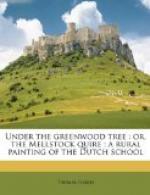Before this moment the church had seemed comparatively empty—now it was thronged; and as Miss Fancy rose from her knees and looked around her for a permanent place in which to deposit herself—finally choosing the remotest corner—Dick began to breathe more freely the warm new air she had brought with her; to feel rushings of blood, and to have impressions that there was a tie between her and himself visible to all the congregation.
Ever afterwards the young man could recollect individually each part of the service of that bright Christmas morning, and the trifling occurrences which took place as its minutes slowly drew along; the duties of that day dividing themselves by a complete line from the services of other times. The tunes they that morning essayed remained with him for years, apart from all others; also the text; also the appearance of the layer of dust upon the capitals of the piers; that the holly-bough in the chancel archway was hung a little out of the centre—all the ideas, in short, that creep into the mind when reason is only exercising its lowest activity through the eye.
By chance or by fate, another young man who attended Mellstock Church on that Christmas morning had towards the end of the service the same instinctive perception of an interesting presence, in the shape of the same bright maiden, though his emotion reached a far less developed stage. And there was this difference, too, that the person in question was surprised at his condition, and sedulously endeavoured to reduce himself to his normal state of mind. He was the young vicar, Mr. Maybold.
The music on Christmas mornings was frequently below the standard of church-performances at other times. The boys were sleepy from the heavy exertions of the night; the men were slightly wearied; and now, in addition to these constant reasons, there was a dampness in the atmosphere that still further aggravated the evil. Their strings, from the recent long exposure to the night air, rose whole semitones, and snapped with a loud twang at the most silent moment; which necessitated more retiring than ever to the back of the gallery, and made the gallery throats quite husky with the quantity of coughing and hemming required for tuning in. The vicar looked cross.
When the singing was in progress there was suddenly discovered to be a strong and shrill reinforcement from some point, ultimately found to be the school-girls’ aisle. At every attempt it grew bolder and more distinct. At the third time of singing, these intrusive feminine voices were as mighty as those of the regular singers; in fact, the flood of sound from this quarter assumed such an individuality, that it had a time, a key, almost a tune of its own, surging upwards when the gallery plunged downwards, and the reverse.
Now this had never happened before within the memory of man. The girls, like the rest of the congregation, had always been humble and respectful followers of the gallery; singing at sixes and sevens if without gallery leaders; never interfering with the ordinances of these practised artists—having no will, union, power, or proclivity except it was given them from the established choir enthroned above them.




